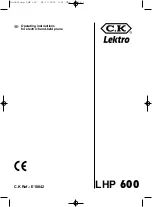
GENERAL INTRODUCTION TO DAB OPERATION
CONNECTING TO AN AERIAL
TUNING FOR THE FIRST TIME
ADJUSTING THE VOLUME
Press the DAB button.
The prefitted telescopic aerial on the unit is used to receive digital radio signals. If the
telescopic aerial does not result in good reception, use the external wire DAB aerial .
1. Screw the aerial plug onto the Aerial connector on the rear of the unit.
2. For the best reception, use the built-in aerial supplied, extend the aerial fully. You may
have to experiment with different angles to find the best reception for particular services.
Just like FM reception, you may find that moving the radio around to find the best
location for reception near a window may provide better reception when inside.
When you switch on your unit for the first time an auto-tuning process will be performed
automatically. A progress indicator on the display shows that auto-tuning is underway.
If stations are found during the auto-tuning
The stations will be stored in alphanumeric order and the first station on the list will be
selected and it will be heard.
If no stations are found during the auto-tuning
Stations no available will be shown on the display for a few seconds and then you see a
menu of options.
Use the Up and Down buttons to scroll through the following options and push it to select
that option.
Once you have tuned your set as explained above you can adjust the volume using the
VOLUME control.
DAB Operation
Channel
Mode
Signal error rate
GUIDE TO DIGITAL RADIO
Displays the channel identifier and frequency for the station to which you are tuning in.
Displays the mode of the current service, Stereo or Mono and the data rate at which the
audio signal is being transmitted. This rate is set by the broadcaster to suit the type and
quality of material being transmitted.
Displays the signal error rate for the signal to which you are tuned. As a guide values from
0 to 15 indicate good reception, 16 to 30 borderline reception and 31 or more poor
reception. This error rate can be improved by adjusting the aerial position using the Tuning
aid option .
This unit enables you to receive and listen to DAB radio programmes. Digital Audio
Broadcast (DAB) uses digital signals rather than traditional analogue signals, the result of
which enables near CD-quality audio and virtually interference-free reception. DAB also
enables broadcasters to transmit additional data along with the audio including other audio
channels, text and in the future , perhaps computer data and images.
Digital radio is broadcast as groups of data called ensembles or multiplexes. Each
multiplex can contain a number of stations (services) and each station contains a primary
services and can contain secondary services as illustrated in the following diagram.
Each multiplex is transmitted in a set
frequency range and received by your unit for
decoding. Your unit enables you to receive multiplexes broadcast in frequency band III
(174-240 MHz) and store the services in each multiplex for you to access. The number of
multiplexes you receive will vary depending on your location. Band III is divided into 41
channels identified as 5A to 13F. Each channel can contain one multiplex . Channels
allocated to the UK Are in the range 11B to12D.
Multiplexes and stations have labels (names) which are used to identify them. Instead of
needing to know a particular frequency to listen to your favourite broadcast you simply
select the station name. Secondary services and additional data such as text containing
programme or multiplex information are also easily accessed using this unit.
DAB Operation (Continued)
16
Goodmans Product Information Helpline 0870 873 0080
17
Goodmans Product Information Helpline 0870 873 0080
































